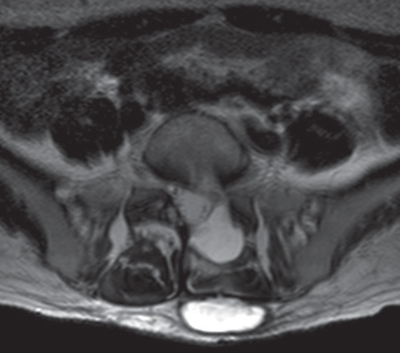49 What are the most common sources of spinal infection? 1. Direct contact through wounds or ulcers 2. Direct contact through infections in other sites (e.g., pharyngeal infections, pyelonephritis, abscesses) 3. Hematogenous spread following infections in other sites (e.g., skin, endocarditis, UTI, and respiratory infection) 4. Following spinal procedure (including epidural procedures) How can spinal infections be divided according to location? 1. Vertebral osteomyelitis 2. Diskitis 3. Epidural abscess 4. Subdural empyema 5. Meningitis 6. Spinal cord abscess What is the treatment of choice for spinal epidural abscess?1 • Surgical evacuation and appropriate antibiotic therapy • In cases with bony destruction from vertebral osteomyelitis where further bony removal would compromise stability, spinal fusion is also necessary. Fig. 49.1 Postlaminectomy fluid collection seen on T2-weighted axial MRI, which may be consistent with an epidural abscess.
Spinal Infections
49.1 Basics
49.2 Epidural Abscess

![]()
Stay updated, free articles. Join our Telegram channel

Full access? Get Clinical Tree






